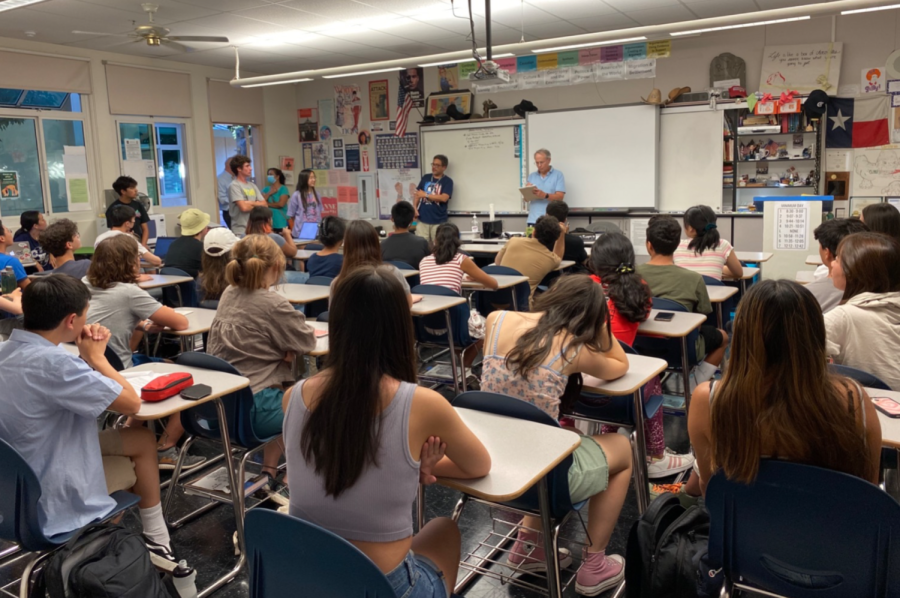Temperatures hit record-breaking highs early this week, reaching over 100 degrees Fahrenheit. Over 2,000 students, faced with no air conditioning in some classrooms, were forced to learn in the heat or relocate to a different classroom. For many, focusing in warm classrooms proved to be the most difficult adjustment.
“There was not much of a difference at lunch or walking to classes; it was more that it was really hot in classes without air conditioning,” said Evelyn Chan, a senior. “It’s harder to pay attention in class because I’m sometimes busy trying to cool off from walking to class by just tying my hair or drinking water.”
Not all classrooms at Carlmont are equipped with air conditioning, causing teachers in non-air-conditioned classrooms to scramble to find alternate rooms to teach in. Some decided to move to available classrooms with air conditioning, while others opted to use the College and Career Center near the Counseling Office. Knowing that the heat would affect the learning environment, teachers with air conditioning offered their classrooms to others during their free periods. However, many others were stuck in hot classrooms.
Gregory Fung, a physics teacher, is one of the teachers whose classroom isn’t equipped with air conditioning. To provide students with an ideal learning space, he moved his classes to the College and Career Center on Tuesday.
“People learn better when they are completely comfortable, so there definitely was an impact [due to the heat], and a lot of students were not comfortable,” Fung said. “If someone asked if I would like air conditioning, of course I would accept it, but you also have to make do with what you have; things aren’t perfect.”
Many students, like Sophie Chong, a freshman, noticed how others were more exhausted and distracted due to the high temperatures.
“When you’re hot, you get more tired, so I saw a lot more people were starting to fall asleep or sit there fanning themselves with a paper, especially after lunchtime,” Chong said. “I know it also distracted a lot of people because they just were not in the right state of mind because of the heat.”
Teachers did their best to reduce the heat in their classrooms by turning off the lights, keeping window blinds closed, and stationing fans along the sides of the room. Nonetheless, these efforts could not change the weather outside.
“In most of my classrooms, the teachers did a pretty good job of keeping the room cool,” Chong said. “But when you step outside, you feel [the heat] just hit you in the face and the heat radiating off the pavement when walking in direct sunlight.”
Not only was learning affected, but planned extracurricular activities also had to endure the heat. Club meetings were changed as student club organizers decided to reschedule or find places out of the heat. Hoping to stay cool, some took refuge in teachers’ air-conditioned classrooms during lunch.
Many sports practices continued, such as water polo, and athletes trained under the burning sun.
“The pool deck was like walking on hot coals,” Chan said.
Seeing how hot some classrooms were, many students and teachers believe it would be best for the school to install air conditioners.
“It’s just not practical to have students and teachers changing classrooms to avoid the heat or moving to the Performing Arts Center or the College and Career Center,” Chan said. “It makes it harder for teachers to collect materials or do experiments for some classes.”
In response to the heat wave, San Mateo County opened cooling centers and libraries for people to visit, with several located in each city. These air-conditioned facilities can support individuals with an elevated risk for potential heat-related illnesses, such as seniors, children, those with pre-existing health conditions, and pets.
On Friday, Gov. Gavin Newsom announced that he had signed legislation to protect Californians from frequent heat waves. According to the statement, $865 million will address extreme heat, with some of the budget planned to plant trees and expand other school greening projects.
With rising temperatures also comes possible power outages. The California Independent System Operator’s (ISO) Flex Alert asks consumers to conserve electricity in case of an energy supply shortage voluntarily. According to a news release, the ISO alerted residents to be ready for potential rotating power outages and declared an Energy Emergency Alert (EEA).
Updated Sept. 10, 2022






















